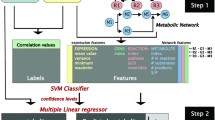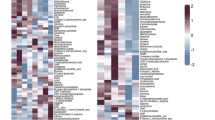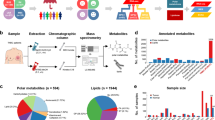Abstract
Objective
Breast cancer (BC) is the most common type of malignant tumor and the most common cause of cancer-related mortality among women. Metabolic reprogramming is considered a hallmark of cancer, and the study of BC metabolism may be the key to the development of new strategies for diagnosis and treatment. In this study, we aimed to explore the potential metabolites and gene biomarkers for BC through the integration of metabolomics and transcriptomic data, which could further understand BC tumor biology.
Methods
Transcriptome dataset GSE139038 was downloaded to explore the differentially expressed genes (DEGs) between BC and normal control (NC) samples. Metabolomics dataset MTBLS326 was downloaded and preprocessed to obtain altered metabolites. Then, the principal component analysis (PCA) and linear models were used to reveal DEGs–metabolites relations. Finally, the pathway enrichment analysis of altered metabolites was performed.
Results
A total of 280 DEGs and eight metabolites were explored between BC and NC samples. The liner module analysis investigated 28 DEGs–metabolites interactions including WASP family member 3 (WASF3)–lactate, ras-related protein Rab-7B (RAB7B)–lactate, and methyltransferase-like 7A (METTL7A)–pyruvate. Finally, pathways analysis showed that these metabolites (such as lactate and pyruvate) were mainly enriched in pathways like disorders of the Krebs cycle.
Conclusions
Combining with the transcriptomic and metabolomics data, we found that lactate, pyruvate, WASF3, RAB7B, and METTL7A might be used as novel biomarkers and potential therapeutic targets for BC. In addition, the disorders of the Krebs cycle pathway might affect the progression of BC.






Similar content being viewed by others
References
Luo SX, Liu JE, Cheng ASK, Xiao SQ, Su YL, Feuerstein M (2019) Breast cancer survivors report similar concerns related to return to work in developed and developing nations. J Occup Rehabil 29(1):42–51. https://doi.org/10.1007/s10926-018-9762-1
Coles CE, Griffin CL, Kirby AM, Titley J, Agrawal RK, Alhasso A, Bhattacharya IS, Brunt AM, Ciurlionis L, Chan C, Donovan EM, Emson MA, Harnett AN, Haviland JS, Hopwood P, Jefford ML, Kaggwa R, Sawyer EJ, Syndikus I, Tsang YM, Wheatley DA, Wilcox M, Yarnold JR, Bliss JM (2017) Partial-breast radiotherapy after breast conservation surgery for patients with early breast cancer (UK IMPORT LOW trial): 5-year results from a multicentre, randomised, controlled, phase 3, non-inferiority trial. Lancet 390(10099):1048–1060. https://doi.org/10.1016/S0140-6736(17)31145-5
Moran MS (2018) Advancements and personalization of breast cancer treatment strategies in radiation therapy. Cancer Treat Res 173:89–119. https://doi.org/10.1007/978-3-319-70197-4_7
Lin M, van Golen KL (2004) Rho-regulatory proteins in breast cancer cell motility and invasion. Breast Cancer Res Treat 84(1):49–60. https://doi.org/10.1023/B:BREA.0000018424.43445.f3
Carpenter CL, Ross RK, Paganini-Hill A, Bernstein L (2003) Effect of family history, obesity and exercise on breast cancer risk among postmenopausal women. Int J Cancer 106(1):96–102. https://doi.org/10.1002/ijc.11186
Ettlin J, Clementi E, Amini P, Malbon A, Markkanen E (2017) Analysis of gene expression signatures in cancer-associated stroma from canine mammary tumours reveals molecular homology to human breast carcinomas. Int J Mol Sci 18(5):1101. https://doi.org/10.3390/ijms18051101
Schulz D, Zanotelli VRT, Fischer JR, Schapiro D, Engler S, Lun XK, Jackson HW, Bodenmiller B (2018) Simultaneous multiplexed imaging of mRNA and proteins with subcellular resolution in breast cancer tissue samples by mass cytometry. Cell Syst 6(1):25-36. e25. https://doi.org/10.1016/j.cels.2017.12.001
Tien JF, Mazloomian A, Cheng S-WG, Hughes CS, Chow CC, Canapi LT, Oloumi A, Trigo-Gonzalez G, Bashashati A, Xu J (2017) CDK12 regulates alternative last exon mRNA splicing and promotes breast cancer cell invasion. Nucleic Acids Res 45(11):6698–6716. https://doi.org/10.1093/nar/gkx187
O’Flanagan CH, Rossi EL, McDonell SB, Chen X, Tsai Y-H, Parker JS, Usary J, Perou CM, Hursting SD (2017) Metabolic reprogramming underlies metastatic potential in an obesity-responsive murine model of metastatic triple negative breast cancer. NPJ Breast Cancer 3:26. https://doi.org/10.1038/s41523-017-0027-5
Eichner LJ, Perry M-C, Dufour CR, Bertos N, Park M, St-Pierre J, Giguère V (2010) miR-378(∗) mediates metabolic shift in breast cancer cells via the PGC-1β/ERRγ transcriptional pathway. Cell Metab 12(4):352–361. https://doi.org/10.1016/j.cmet.2010.09.002
Luo X, Yu H, Song Y, Sun T (2019) Integration of metabolomic and transcriptomic data reveals metabolic pathway alteration in breast cancer and impact of related signature on survival. J Cell Physiol 234(8):13021–13031. https://doi.org/10.1002/jcp.27973
Budczies J, Denkert C, Müller BM, Brockmöller SF, Klauschen F, Györffy B, Dietel M, Richter-Ehrenstein C, Marten U, Salek RM (2012) Remodeling of central metabolism in invasive breast cancer compared to normal breast tissue—a GC-TOFMS based metabolomics study. BMC Genomics 13:334. https://doi.org/10.1186/1471-2164-13-334
Hassan MA, Al-Sakkaf K, Shait Mohammed MR, Dallol A, Al-Maghrabi J, Aldahlawi A, Ashoor S, Maamra M, Ragoussis J, Wu W, Khan MI, Al-Malki AL, Choudhry H (2020) Integration of transcriptome and metabolome provides unique insights to pathways associated with obese breast cancer patients. Front Oncol 10:804. https://doi.org/10.3389/fonc.2020.00804
Ara T, Enomoto M, Arita M, Ikeda C, Kera K, Yamada M, Nishioka T, Ikeda T, Nihei Y, Shibata D, Kanaya S, Sakurai N (2015) Metabolonote: a wiki-based database for managing hierarchical metadata of metabolome analyses. Front Bioeng Biotechnol 3:38. https://doi.org/10.3389/fbioe.2015.00038
Barrett T, Troup D, Wilhite S, Ledoux P, Rudnev D, Evangelista C, Kim I, Soboleva A, Tomashevsky M, Edgar R (2007) NCBI GEO: mining tens of millions of expression profiles–database and tools update. Nucleic Acids Res 35(Database):760–765. https://doi.org/10.1093/nar/gkl887
Gautier L, Cope L, Bolstad B, Irizarry R (2004) affy–analysis of Affymetrix GeneChip data at the probe level. Bioinformatics 20(3):307–315. https://doi.org/10.1093/bioinformatics/btg405
Ritchie M, Phipson B, Wu D, Hu Y, Law C, Shi W, Smyth G (2015) Limma powers differential expression analyses for RNA-sequencing and microarray studies. Nucleic Acids Res 43(7):e47. https://doi.org/10.1093/nar/gkv007
Siddiqui JK, Baskin E, Liu M, Cantemir-Stone CZ, Zhang B, Bonneville R, McElroy JP, Coombes KR, Mathe EA (2018) IntLIM: integration using linear models of metabolomics and gene expression data. BMC Bioinformatics 19(1):81. https://doi.org/10.1186/s12859-018-2085-6
Kamburov A, Cavill R, Ebbels TMD, Herwig R, Keun HC (2011) Integrated pathway-level analysis of transcriptomics and metabolomics data with IMPaLA. Bioinformatics 27(20):2917–2918. https://doi.org/10.1093/bioinformatics/btr499
Kumar A, Misra BB (2019) Challenges and opportunities in cancer metabolomics. Proteomics 19(21–22):e1900042. https://doi.org/10.1002/pmic.201900042
Zhang G, He P, Tan H, Budhu A, Gaedcke J, Ghadimi BM, Ried T, Yfantis HG, Lee DH, Maitra A, Hanna N, Alexander HR, Hussain SP (2013) Integration of metabolomics and transcriptomics revealed a fatty acid network exerting growth inhibitory effects in human pancreatic cancer. Clin Cancer Res 19(18):4983–4993. https://doi.org/10.1158/1078-0432.ccr-13-0209
Teng Y, Qin H, Bahassan A, Bendzunas NG, Kennedy EJ, Cowell JK (2016) The WASF3-NCKAP1-CYFIP1 complex is essential for breast cancer metastasis. Cancer Res 76(17):5133–5142. https://doi.org/10.1158/0008-5472.can-16-0562
Stovold CF, Millard TH, Machesky LM (2005) Inclusion of Scar/WAVE3 in a similar complex to Scar/WAVE1 and 2. BMC Cell Biol 6(1):11. https://doi.org/10.1186/1471-2121-6-11
Insall RH, Machesky LM (2009) Actin dynamics at the leading edge: from simple machinery to complex networks. Dev Cell 17(3):310–322. https://doi.org/10.1016/j.devcel.2009.08.012
Teng Y, Bahassan A, Dong D, Hanold LE, Ren X, Kennedy EJ, Cowell JK (2016) Targeting the WASF3-CYFIP1 complex using stapled peptides suppresses cancer cell invasion. Cancer Res 76(4):965–973. https://doi.org/10.1158/0008-5472.can-15-1680
Teng Y, Pi W, Wang Y, Cowell JK (2016) WASF3 provides the conduit to facilitate invasion and metastasis in breast cancer cells through HER2/HER3 signaling. Oncogene 35(35):4633–4640. https://doi.org/10.1038/onc.2015.527
Yang M, Chen T, Han C, Li N, Wan T, Cao X (2004) Rab7b, a novel lysosome-associated small GTPase, is involved in monocytic differentiation of human acute promyelocytic leukemia cells. Biochem Biophys Res Commun 318(3):792–799. https://doi.org/10.1016/j.bbrc.2004.04.115
Wen H, Zhan L, Chen S, Long L, Xu E (2017) Rab7 may be a novel therapeutic target for neurologic diseases as a key regulator in autophagy. J Neurosci Res 95(10):1993–2004. https://doi.org/10.1002/jnr.24034
Ebner P, Poetsch I, Deszcz L, Hoffmann T, Zuber J, Ikeda F (2018) The IAP family member BRUCE regulates autophagosome-lysosome fusion. Nat Commun 9(1):599. https://doi.org/10.1038/s41467-018-02823-x
Liu H, Xu J, Yao Q, Zhang Z, Guo Q, Lin J (2020) Rab7is associated with poor prognosis of gastric cancer and promotes proliferation, invasion, and migration of gastric cancer cells. Med Sci Monit 26:e922217. https://doi.org/10.12659/msm.922217
Sun C, Wang P, Dong W, Liu H, Sun J, Zhao L (2020) LncRNA PVT1 promotes exosome secretion through YKT6, RAB7, and VAMP3 in pancreatic cancer. Aging (Albany NY) 12(11):10427–10440. https://doi.org/10.18632/aging.103268
Kou X, Yang Y, Jiang X, Liu H, Sun F, Wang X, Liu L, Liu H, Lin Z, Jiang L (2017) Vorinostat and Simvastatin have synergistic effects on triple-negative breast cancer cells via abrogating Rab7 prenylation. Eur J Pharmacol 813:161–171. https://doi.org/10.1016/j.ejphar.2017.08.022
Zhou S, Shen Y, Zheng M, Wang L, Che R, Hu W, Li P (2017) DNA methylation of METTL7A gene body regulates its transcriptional level in thyroid cancer. Oncotarget 8(21):34652–34660. https://doi.org/10.18632/oncotarget.16147
Jun F, Peng Z, Zhang Y, Shi D (2020) Quantitative proteomic analysis identifies novel regulators of methotrexate resistance in choriocarcinoma. Gynecol Oncol 157(1):268–279. https://doi.org/10.1016/j.ygyno.2020.01.013
Armitage EG, Ciborowski M (2017) Applications of metabolomics in cancer studies. Adv Exp Med Biol 965:209–234. https://doi.org/10.1007/978-3-319-47656-8_9
Mu X, Shi W, Xu Y, Xu C, Zhao T, Geng B, Yang J, Pan J, Hu S, Zhang C, Zhang J, Wang C, Shen J, Che Y, Liu Z, Lv Y, Wen H, You Q (2018) Tumor-derived lactate induces M2 macrophage polarization via the activation of the ERK/STAT3 signaling pathway in breast cancer. Cell Cycle 17(4):428–438. https://doi.org/10.1080/15384101.2018.1444305
Zhao Y, Zhou M, Liu H, Ding Y, Khong H, Yu D, Fodstad O, Tan M (2009) Upregulation of lactate dehydrogenase A by ErbB2 through heat shock factor 1 promotes breast cancer cell glycolysis and growth. Oncogene 28(42):3689–3701. https://doi.org/10.1038/onc.2009.229
Martel F, Guedes M, Keating E (2016) Effect of polyphenols on glucose and lactate transport by breast cancer cells. Breast Cancer Res Treat 157(1):1–11. https://doi.org/10.1007/s10549-016-3794-z
Chen P, Zuo H, Xiong H, Kolar MJ, Chu Q, Saghatelian A, Siegwart DJ, Wan Y (2017) Gpr132 sensing of lactate mediates tumor-macrophage interplay to promote breast cancer metastasis. Proc Natl Acad Sci U S A 114(3):580–585. https://doi.org/10.1073/pnas.1614035114
Elia I, Rossi M, Stegen S, Broekaert D, Doglioni G, van Gorsel M, Boon R, Escalona-Noguero C, Torrekens S, Verfaillie C, Verbeken E, Carmeliet G, Fendt SM (2019) Breast cancer cells rely on environmental pyruvate to shape the metastatic niche. Nature 568(7750):117–121. https://doi.org/10.1038/s41586-019-0977-x
Jin L, Chun J, Pan C, Alesi GN, Li D, Magliocca KR, Kang Y, Chen ZG, Shin DM, Khuri FR, Fan J, Kang S (2017) Phosphorylation-mediated activation of LDHA promotes cancer cell invasion and tumour metastasis. Oncogene 36(27):3797–3806. https://doi.org/10.1038/onc.2017.6
Murphy MP, O’Neill LA (2018) Krebs cycle reimagined: the emerging roles of succinate and itaconate as signal transducers. Cell 174(4):780–784. https://doi.org/10.1016/j.cell.2018.07.030
Sajnani K, Islam F, Smith RA, Gopalan V, Lam AK-Y (2017) Genetic alterations in Krebs cycle and its impact on cancer pathogenesis. Biochimie 135:164–172. https://doi.org/10.1016/j.biochi.2017.02.008
Liu WS, Chan SH, Chang HT, Li GC, Tu YT, Tseng HH, Fu TY, Chang HY, Liou HH, Ger LP, Tsai KW (2018) Isocitrate dehydrogenase 1-snail axis dysfunction significantly correlates with breast cancer prognosis and regulates cell invasion ability. Breast Cancer Res 20(1):25. https://doi.org/10.1186/s13058-018-0953-7
Author information
Authors and Affiliations
Contributions
YY carried out the conception and design of the research. YZ participated in the acquisition of data. XL and YZ carried out the analysis and interpretation of data. XZ participated in the design of the study and performed the statistical analysis. YY and BY conceived of the study, participated in its design and coordination and helped to draft the manuscript and revision of manuscript for important intellectual content. All authors read and approved the final manuscript.
Corresponding author
Ethics declarations
Conflict of interest
The authors declare that they have no competing interests.
Additional information
Publisher's Note
Springer Nature remains neutral with regard to jurisdictional claims in published maps and institutional affiliations.
Rights and permissions
About this article
Cite this article
Yang, Y., Zhu, Y., Li, X. et al. Identification of potential biomarkers and metabolic pathways based on integration of metabolomic and transcriptomic data in the development of breast cancer. Arch Gynecol Obstet 303, 1599–1606 (2021). https://doi.org/10.1007/s00404-021-06015-9
Received:
Accepted:
Published:
Issue Date:
DOI: https://doi.org/10.1007/s00404-021-06015-9




